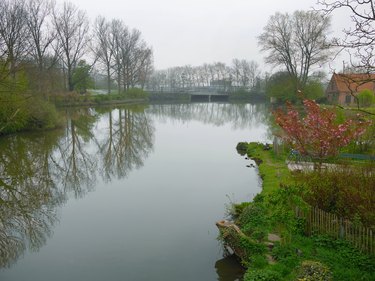
Lakeshore sites provide critical habitat to a large variety of wildlife species. Plant trees that grow by water, preferably native species, that thrive when their feet are wet. Their limbs will shade you while their roots provide restful nooks for lake fish. Avoid removing trees and planting a lawn to the lake edge, which damages the natural environment and can degrade the lake by allowing pollutants and fertilizers to run into the water unchecked.
Plant Trees that Grow Near Water
Video of the Day
Willow trees (Salix spp.) and smaller shrubs of the willow family make ideal lake-side plantings in U.S. Department of Agriculture plant hardiness zones 2 through 10, depending on the species. The native black willow (Salix nigra), hardy in USDA zones 4 through 9, has graceful, bamboolike leaves and its trunks can grow to a huge diameter with intriguing knobs and twists to accent your landscape. A black willow grows 30 to 60 feet tall and equally wide.
Video of the Day
The weeping willow (Salix babylonica), originally from China, features elegant draping branches that form a shady room, perfect for midsummer lake-side picnics in USDA zones 2 through 9. Among the best plants for a lake shoreline, willow roots thrive in wet soil and help prevent the waterside banks from eroding. Avoid planting willow trees near water lines and septic systems, the roots seek water sources. A mature weeping willow may reach 30 to 50 tall and wide.
Add Edible Fruit Trees
Native fruit trees near the shoreline can provide food and nesting spots for songbirds, beautiful flowers in springtime and a tasty harvest for your own homemade jam. The Canadian serviceberry (Amelanchier canadensis), also known as shadbush and wild current, is a small understory tree that blooms early in the season and bears prolific purplish fruits in USDA zones 4 through 7. The fruits can be enjoyed fresh or dried, in pies and other baked goods or made into jam or wine.
In USDA zones 4 through 9, the American persimmon (Diospyros virginiana) is one of the trees that grow by water. Under ideal conditions, it may grow up to 80 feet tall, but in poor soils, it may grow as a shrubby 15-foot-tall tree. The American persimmon generally needs two trees, a male and a female, to produce fruit.
Black cherry (Prunus serotina) can grow to towering heights, up to 80 feet tall and 60 feet wide, with ragged dark bark that adds dramatic winter landscape texture. It thrives in moist, well-drained soils in USDA zones 2 through 8. While the fruits are enjoyed by wildlife, all parts of the tree are highly toxic to humans, pets and horses. Avoid planting where children and pets may have access to any fallen fruits and leaves.
Consider the Mighty Oaks
Oak trees (Quercus spp.) like well-drained soil, and thrive slightly back from a lake, along a raised bank where they can take advantage of the nearby water source with their deep roots, but not sit with their feet wet. Pin oak (Quercus palustris), hardy in USDA zones 4 through 8, and water oak (Quercus nigra) and willow oak (Quercus phellos), both hardy in USDA zones 6 through 9, make good choices near water bodies. The northern red oak (Quercus rubra), white oak (Quercus alba) and post oak (Quercus stellata) thrive in USDA zones 4 through 8, 3 through 9 and 5 through 9, respectively. These trees also like the sandy, well-drained soils near lakes, advises the Center for Coastal Resource Management.
Choose Classics: Ash and Cottonwood
Two classic trees of American shorelines and riverbanks are the green ash (Fraxinus pennsylvanica) and the Eastern cottonwood (Populus deltoides), which are known as trees that grow by water. Both grow to impressive height and girth on the water's edge in USDA zones 3 through 9. The Eastern cottonwood produces a sea of white seed puffs in mid-spring which drift like dandelion seed heads, looking like late season snow. Some landowners enjoy this display while others eschew the cottonwood tree as messy.
- Center for Coastal Resource Management: Living Shorelines -- Plants for Salt Marshes and Upland Banks
- Missouri Botanical Garden: Salix nigra
- University of Florida IFAS Extension: Salix Babylonica: Weeping Willow
- Natural Resources Conservation Service: Canadian Serviceberry
- North Carolina Extension Gardener Plant Tool: Prunus serotinabox:
- North Carolina Extension Gardener Plant Toolbox: Diospyros virginiana